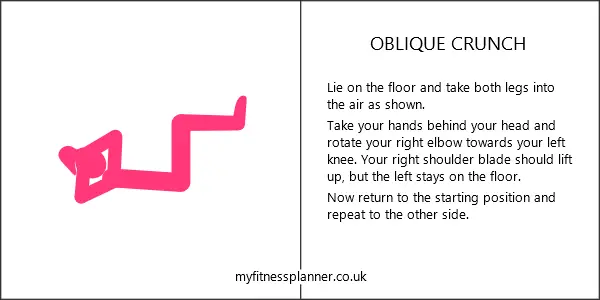
Intensity level: intermediate
Benefits: all the exercises in this challenge work the 6 pack muscles and some also work the deeper core muscles
Safety: please read the general safety information here
What you need: you need an exercise mat, or some other form of cushioning for your spine. See an exercise mat buying guide here.
60 day 6-pack challenge chart
The challenge is split into 2 groups of exercises which you do on alternate days.
From day 22 onwards, there are more than 1 set of the exercises. This means that you do all 3 exercises for the number of reps given that day, then repeat for the number of sets given.
The chart shows which exercises you should do (group 1 or 2), how many reps you should do of each exercise and how many sets you should do (day 22 onwards). Instructions for the exercises are below the chart.

Exercise instructions
Group 1 exercises






About the “6 pack muscles”
The 6-pack is a pair of muscles divided into sections by tendons. The correct name for the muscles is the recti abdominis (singular rectus abdominis) and its main purpose is to flex the spine.
The rectus abdominis is a long, flat muscle that runs from the sternum to the pubic bone. It is divided into three sections, or tendinous intersections, which are the lines that you can see on the abdomen when the muscles are contracted. The number of intersections can vary from person to person, but the “6-pack” appearance is the most common.
In order to have a visible 6-pack, you need to have low body fat. The rectus abdominis is covered by a layer of fat, and if this layer is too thick, the muscles will not be visible. You can reduce body fat by eating a healthy diet and exercising regularly.
In addition to reducing body fat, you also need to build muscle in the rectus abdominis. This can be done by performing exercises that target the abdominals, such as those in this challenge.
Related to 60 day 6-pack challenge
Further reading
Diastasis recti is the separation of the two rectus muscles during pregnancy. Read more about it here.
Last Updated on: September 12, 2025
